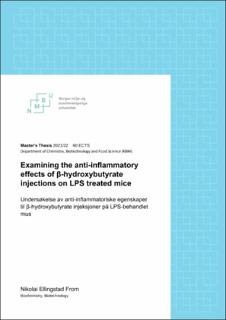| dc.description.abstract | Abstract
Background:
Elevated levels of ketones, especially β-Hydroxybutyrate (BHB), have been proposed to impact several essential mechanisms in the immune system. This is mainly suggested through the anti-inflammatory properties observed in studies on elevated BHB concentrations in mice and cell cultures. Inflammation is considered the essential mechanism of the innate immune response, a response against harmful pathogens as well as important for damaged tissue repair and regeneration. While beneficial in the short term, excessive inflammation can lead to a state of chronic inflammation, linked to several important diseases. Some of these diseases are cardiovascular diseases, cancer, autoimmune diseases, and several neurodegenerative diseases. With BHB implicated in several mechanisms central to the inflammation process, three suggested interactions are highly important for this project.
1) BHB inhibiting NLRP3 inflammasome activation through interactions with potassium efflux channels and reactive oxygen species (ROS). This negatively impacts the maturation of pro-inflammatory cytokines IL-1β and IL-18.
2) BHB as an HDAC inhibitor that can upregulate expression of molecules protecting against oxidative stress or directly impact the NF- subunits through phosphorylation.
3) BHB acting as a GPR109a agonist, a mechanism proven to reduce colon inflammation.
Aim: The goal of the project is to examine if four bolus injections of different BHB containing solutions can reduce the severity of acute systemic inflammation in mice treated with LPS.
Methods: 26 transgenic mice were sorted into four groups, all given a different amount of BHB. Group 1, the control, was only given a saline solution with 0 mM BHB. Group 2 was given 5 mmol/kg BHB solution (Low). Group 3 was given 10 mmol/kg BHB solution (Medium), and group 4 was given 15 mmol/kg BHB (High). The severity of the inflammation caused by LPS was measured through in vivo imaging of NF- activity and cytokine profiling from plasma samples.
Results: While a substantial NF- activity was observed through in vivo imaging, no dose dependent relationship between BHB and NF- activity was found. Male mice on average were found to exhibit a higher NF- activity compared to the female mice. Data from cytokine profiling showed a greater IFN-γ concentration in plasma samples from the male mice compared to those from females. A positive dose dependent effect of BHB on IL-10 and IL-6 were found.
Conclusion: We did not observe reduction in NF- activity in any of the groups given BHB. With BHB theorized to inhibit NLRP3i activation, it was expected to see a dose dependent reduction of IL-1β and IL-18. Instead, a dose dependent increase in IL-6 and IL-10 were observed. | |
